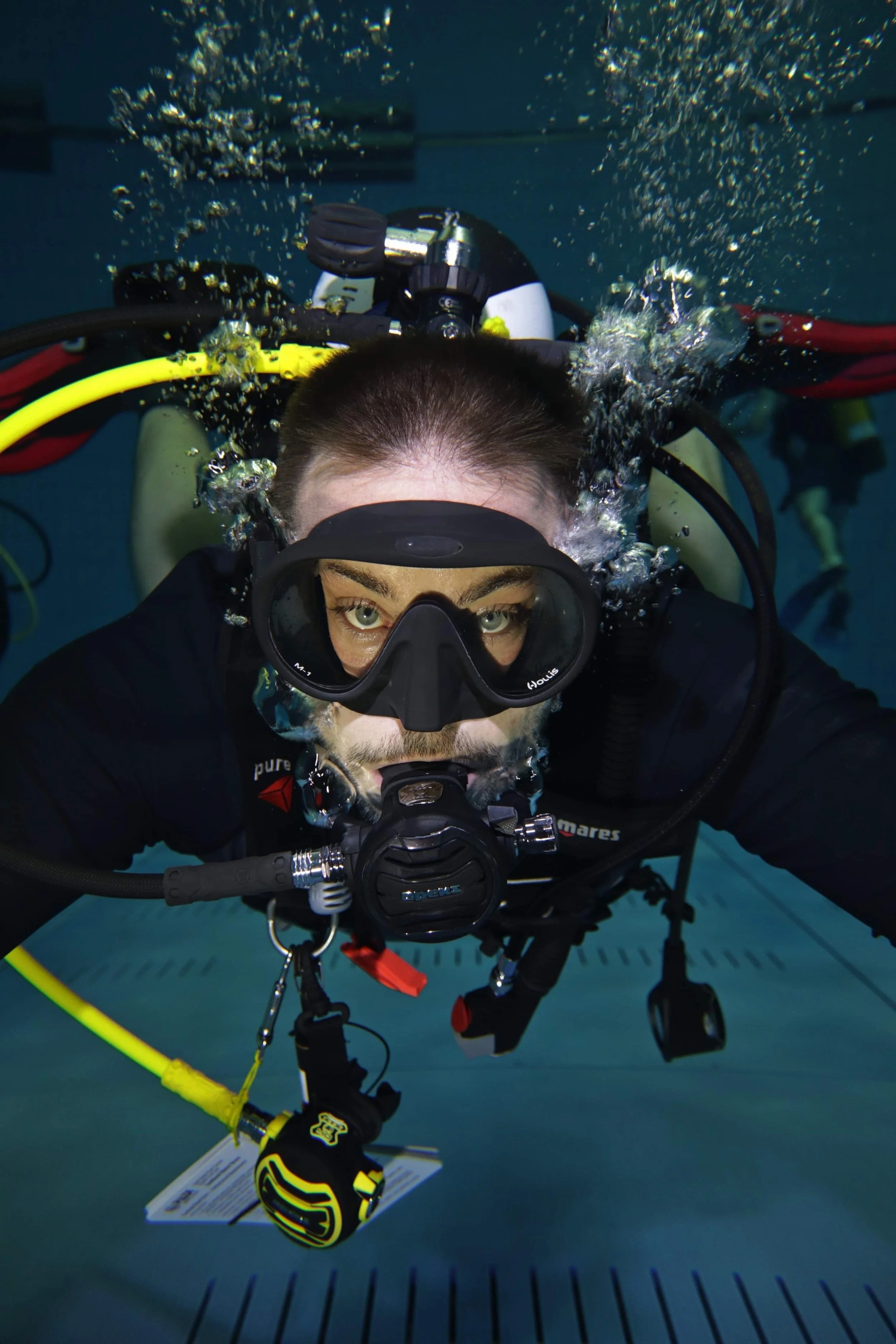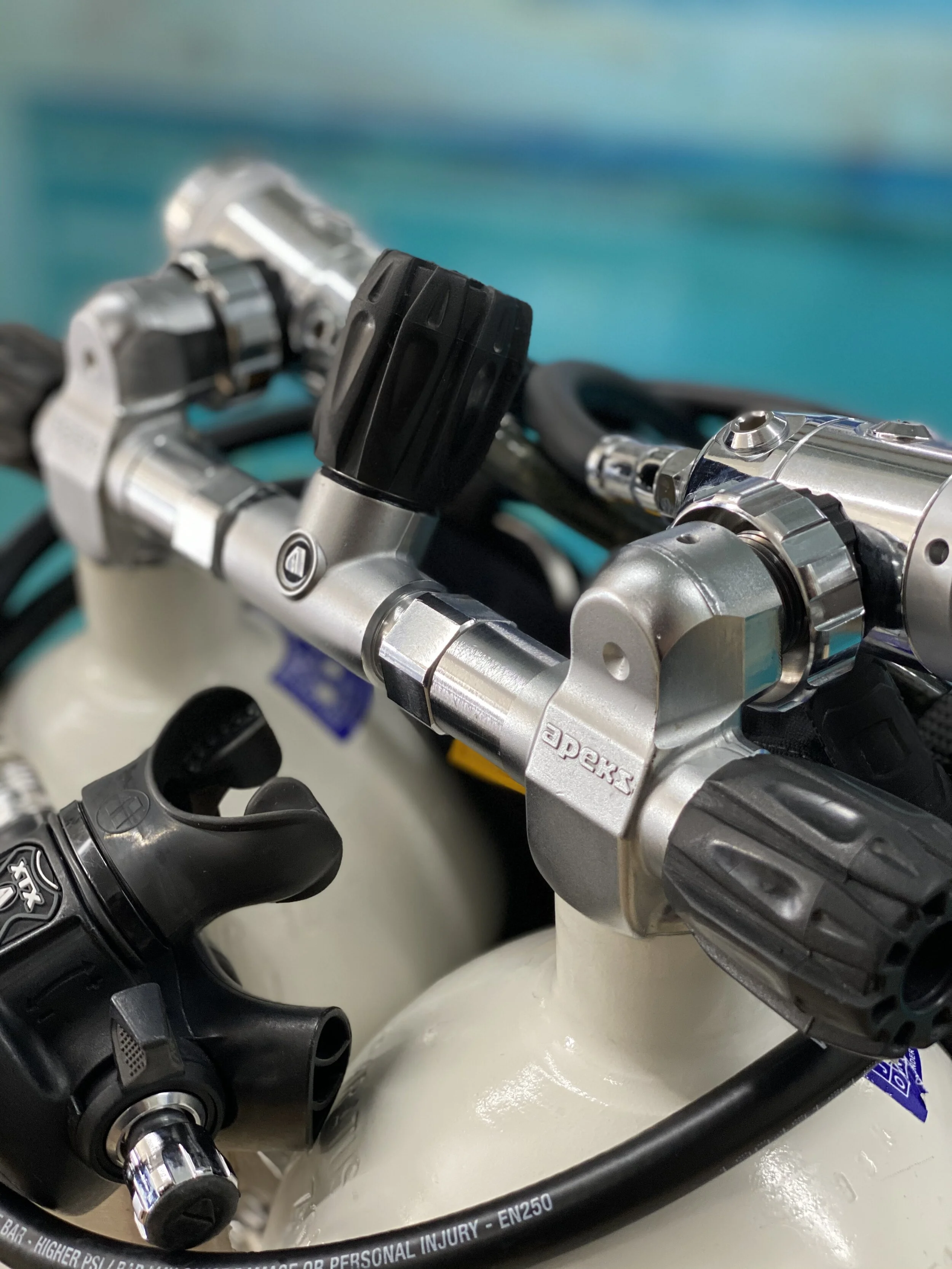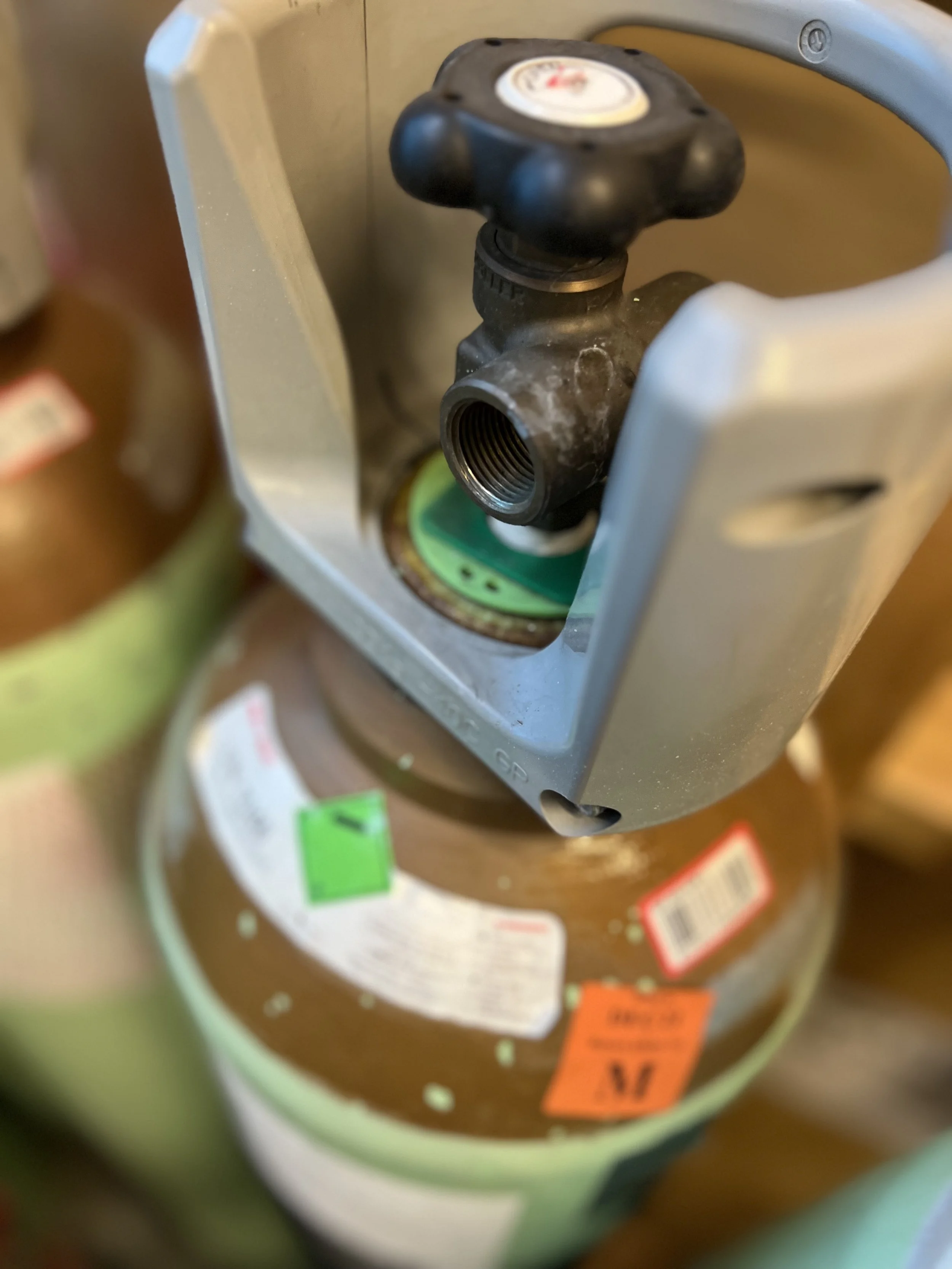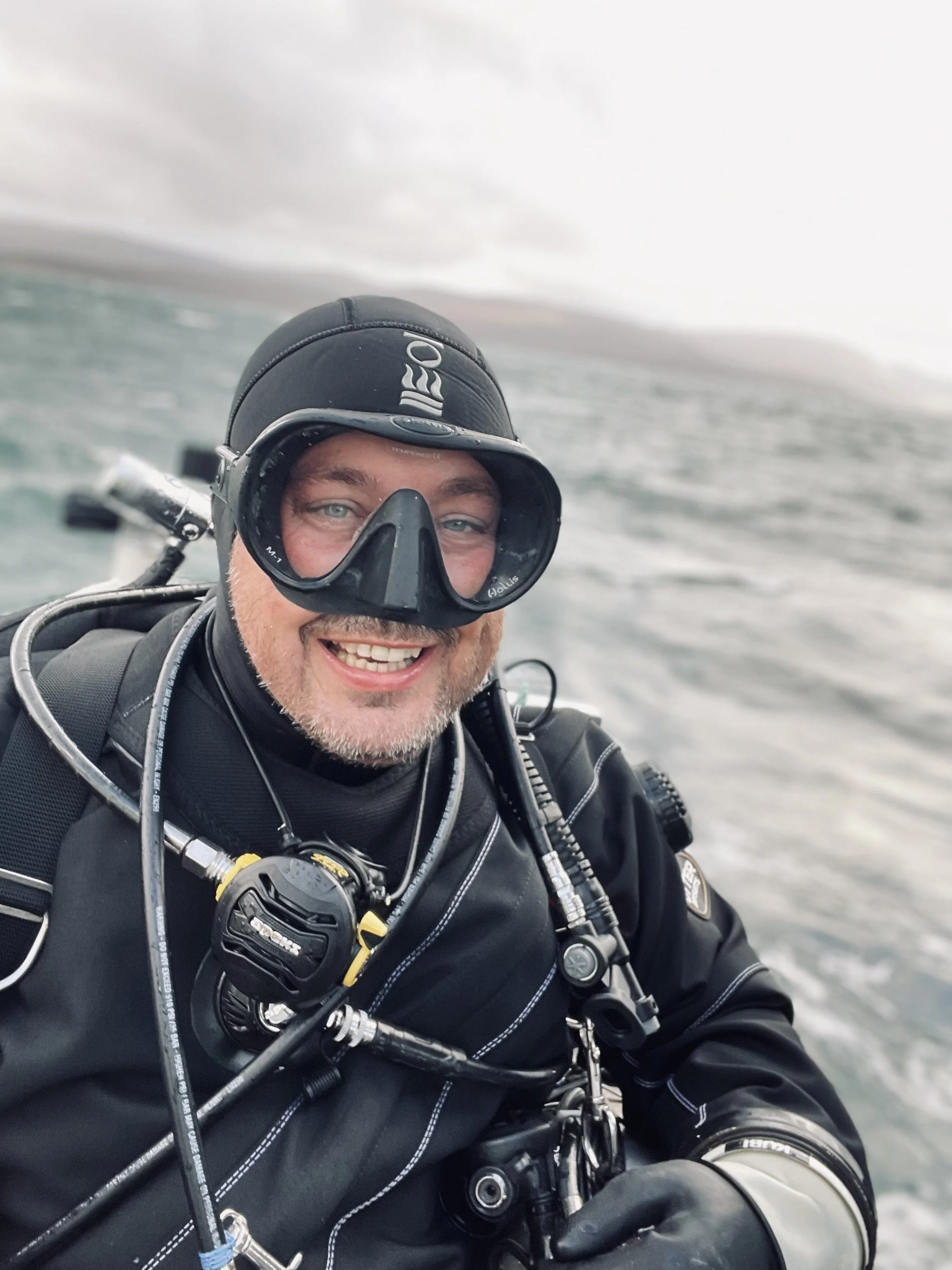A Guide To Diving Gasses
In simple terms, a breathing gas is basically a mixture of gaseous chemical elements and compounds used for respiration, but what exactly is air, nitrox and trimix and why do we use them?
Why not take a few moments and let SEPE Diving help you understand some of the most readily available breathing gasses on the open market.
Breathing Air
The first gas that we are going to look at is undeniably the most common and only naturally available breathing gas, containing approximately 21% oxygen and 79% nitrogen.
As an aid to understanding the basics, it helps to know that oxygen is by far the most essential component in any breathing gas, but it’s also the only metabolically active one, usually at a partial pressure of between 0.16 and 1.60 PPO2 (Partial Pressure of O2).
Only a small amount of the oxygen is actually consumed during the metabolic process with the inert component such as the nitrogen, remaining unchanged. An inert gas generally only serves to dilute the oxygen to an appropriate concentration, so in scuba these components are referred to as diluent gasses.
PARTIAL PRESSURES, WHAT ARE THEY AND WHY ARE THEY IMPORTANT?
In 1801, physicist John Dalton proclaimed that in a mixture of non-reacting gasses, the total pressure exerted collectively by all gasses in the mix is equal to the partial pressure of each individual gas. The partial pressure is therefore the pressure that each gas would exert if it alone occupied the volume of the mixture at the same temperature.
As an example, at the surface whilst at a pressure of 1 bar ATA (atmospheres absolute), the partial pressure of the oxygen component of breathing air when expressed as decimal is 0.21 PPO2 (21%), and 0.79 PPN2 (79%) for the nitrogen.
SAFE LIMITS - MINIMUM AND MAXIMUM PPO2’s
The partial pressure of a gas is of huge importance to divers because of the risks presented when operating outside of otherwise safe limits. Thankfully these limits are easy to manage through pre-dive gas planning. Furthermore, most modern computers when set are able to alert a diver if they come close to exceeding the maximum recommended PPO2, thus giving them plenty of notice to shallow up.
MINIMUM PARTIAL PRESSURE
The minimum PPO2 for oxygen use and necessary in order to sustain life is 0.16 (16% O2 at the surface). Below this, a diver is exposed to the risk of losing consciousness through a condition known as hypoxia (where the body is not supplied with enough oxygen to meet demands). Although there is no exact scientific formula to determine the likely occurrence of hypoxia, exertion and physiology are scientifically considered as contributing factors.
Any breathing gas which contains less than 21% O2 is regarded as being hypoxic, and when a hypoxic mix is breathed in shallow water, the PPO2 is generally insufficient to keep a diver conscious. Because of this, normoxic (normal oxygen concentration) and hyperoxic (a mix which contains more than 21% oxygen) travel gases are used at medium depths between the bottom and the decompression phases of a dive.
MAXIMUM PARTIAL PRESSURE
The maximum recommended safe partial pressure of oxygen during any working or active phase of a dive subject to the increased exposure to exertion whist breathing a high-density gas mix is widely regarded as 1.40, although military divers are often exposed to higher.
In technical diving, the maximum partial pressure of oxygen for decompression is 1.60, but this is also accepted as a small margin for error if 1.40 is exceed for a short time during the working phase, although it is not recommended.
MAXIMUM OPERATING DEPTH (M.O.D)
Diving on a gas where the PPO2 exceeds the maximum creates the avoidable risk of a diver experiencing oxygen toxicity, and possibly a seizure. Where this may not cause a huge problem while on dry land, underwater however this is a very different matter altogether.
Because of the risk of a diver experiencing oxygen toxicity, a maximum operating depth or M.O.D is applied to all gas mixes. This is the safe point in which the PPO2 either reaches or closely nears 1.40 for a given depth. If using air as an example, the point in which a PPO2 of 1.40 is reached is 56.6 meters.
To find this value we use the simple equation:
1.40 (maximum PPO2) divided by 0.21 (fraction of oxygen in air) = 6.66 bar ATA
6.66 bar ATA converted to depth in meters = 56.66m
ASK THE EXPERT
BREATHING AIR
PROS & CONS
PROS
Readily and instantly available almost everywhere
Inexpensive to obtain a fill
No specialist use qualifications required
CONS
Gas narcosis risk below 30m
Maintaining a safe PPO2 limits dives to 56m
Higher nitrogen content restricts NDL’s and determines longer surface intervals
M.O.D
56.6M @ 1.40 PPO2
AVAILABLE TO BUY
ALMOST ANY DIVE CENTRE
COST PER FILL (UK)
£5 (BASED ON A SINGLE 232 BAR CYLINDER)
Enriched Air
The second breathing gas on our list is enriched air (or as it’s better known Nitrox), but what actually is it and what benefits does using it present?
You may have already completed, or be interested in, the PADI Enriched Air Diver Specialty Course, or have recently returned from a liveaboard where you observed other divers using such blends. Let us help you understand why your enriched air certification is well worth having…
NITROGEN AND NO DECOMPRESSION LIMITS
Every diver knows that the 2 primary factors which usually limit their time underwater is gas consumption and a no decompression limit (NDL).
Where this blog sadly can’t do much for your gas consumption, it can help you understand why NDL’s are a bit of a issue, especially when your running out of time and still wanting to have fun.
In short, a no decompression limit or ‘no stop limit’ is simply a limit on the amount of time that a diver can stay at a given depth because of the theoretical build up of nitrogen in their body.
UNDERSTANDING DECOMPRESSION
Whilst underwater, a divers body absorbs nitrogen from breathing compressed gas which is retained in ‘tissue compartments’.
As gasses compress at depth (see Boyles Law), this compressed gas expands or ‘de-compresses’ as a diver ascends, so it is vital that they can either limit or reduce as much of this as possible. In short, during an ascent, small or ‘silent’ bubbles are formed in the body as the inert gas fails to remain in solution. This, in extreme cases where respective decompression procedures and protocols are not followed can cause decompression sickness.
Both dive computer and table NDL’s are conservatively calculated so that recreational divers do not dive for periods long enough to bring all tissues into equilibrium with the partial pressures of the inert components of the breathing gas used. This is known as reaching a state of ‘saturation’. Becoming saturated isn’t in itself actually a problem, it’s making an ascent once you have. Without technical training and sufficient gas blends to meet or accelerate any decompression obligation, you are almost certainly predisposing yourself to risk of serious injury.
Recreational divers must expectedly limit their time at depth to avoid becoming saturated so that they can always make a direct ascent to the surface without any mandatory stops if required. For technical divers, understanding, planning and managing decompression is at the very heart of the PADI Tec Deep program.
Due to the extended durations technical divers spend both underwater and at at depth, reaching a state of saturation is generally inevitable so it can be highly dangerous for them to make a direct ascent to the surface. This is why they must undergo a lengthy rigorous training process to earn themselves the highly coveted PADI Tec50 certification be able to safely manage this.
If a saturated diver ascends or even surfaces, they become supersaturated, meaning the PPN2 of inert gas in the body is greater than their surrounding pressure. It is this reaction which predisposes them to decompression sickness, or what is known in the dive industry as getting a bend or ‘the bends’.
SO WHAT DOES ENRICHED AIR ACTUALLY DO?
Enriched air is basically a breathing gas which contains more than 21% oxygen. PADI recreational divers who complete this respective specialty course are certified to use 22-40% blends of enriched air. This means their desired blend of choice will contain between 22-40% oxygen, with the two most common requested mixes being nitrox 32 and 34%.
Technical divers decompress on blends of anywhere between 50 and 100%, but this again requires special training to manage these NOTOX gas switches far beyond that found within mainstream recreational diving.
By increasing the oxygen content in a breathing gas and further limiting the nitrogen component, we are able to reduce the build up of inert gas in a divers body, allowing them to enjoy a longer dive and a shorter surface interval. Expectedly however, this does not come without a small risk.
THE RISKS OF USING ENRICHED AIR
Characteristically, this once regarded as a ‘taboo’ gas doesn’t really present much of a risk at all, but close attention needs to be paid to the partial pressure of a divers chosen blend.
We already know that the maximum recommended PPO2 for the active portion of a dive is 1.40, so the issue we have when using enriched air is how quickly that limit is achieved when using a larger fraction of oxygen.
If for example, instead of using simple air (which we know has an oxygen content of 21%), we choose to dive with a 40% blend of enriched air, the maximum operating depth would reduce from 56m to 25m to remain with in safe limits and avoid oxygen toxicity.
To find this value we use the equation:
1.40 (maximum PPO2) divided by 0.40 (fraction of oxygen in the mix) = 3.5 bar ATA
3.5 bar ATA converted to depth in meters = 25m
ASK THE EXPERT
ENRICHED AIR / NITROX
PROS & CONS
PROS
Lower nitrogen content
Longer NDL’s
Shorter surface intervals
CONS
Can become expensive depending on the percentage of O2 required
Specialist qualifications needed
Not always availible on demand or as you wait
M.O.D
54M 22% @ 1.40 PPO2 to 25M 40% @ 1.40 PPO2
AVAILABLE TO BUY
MOST DIVE CENTRES BUT NOT ALL
COST PER FILL (UK)
O2 charged at between 0.02p to 0.04p per litre + £5 air top
TRIMIX
Trimix is by far the most complex and staggeringly expensive breathing gas available from a dive centre or store, but it’s generally only reserved for the technical elite.
Trimix is our third and final breathing gas, consisting of helium, oxygen and nitrogen. Trimix is not to be confused with Heliox, which contains only oxygen and helium with 0% nitrogen.
UNDERSTANDING GAS NARCOSIS
To aid your understanding as to why we use helium, all certified PADI divers should have a basic comprehension of gas narcosis, but for those who don’t, lets have a quick recap.
Gas narcosis is the name given to the anaesthetic phenomenon when a diver breathing underwater suffers from an assortment of adverse effects related to the depth they are at. The exact causation for this is not yet fully understood, but it is widely believed that the gas a diver breathes whilst under pressure can have an adverse effect on signal transmission in their central nervous system, thus causing them intoxicating effects.
Whilst breathing air, divers experience the onset of gas narcosis at approximately 30m, and cold water and limited visibility can often predispose them further to exposure.
Initially, the effects of gas narcosis include slowed thinking, a mild feeling of euphoria, and increased problem-solving times, but as a diver goes deeper, the intoxication becomes more profound. Reaction times grow significantly, physical movements and motor skills are reduced, with simple skills becoming significantly harder to achieve. The diver will not be able to concentrate on the tasks at hand and can lose control of the dive through lack of awareness or poor judgment. A diver can also experience visual and auditory disturbances, vertigo, and adverse psychological reactions at extreme depths, including fear, panic, depression, and paranoia.
REDUCING THE NARCOTIC EFFECTS WITH HELIUM
Helium is usually added as a substitute for some of the nitrogen to reduce the narcotic effect of breathing gas at depth. But what some may not know is that helium is also used to reduce the oxygen component of a blend, and thus the inherent risk of a diver experiencing oxygen toxicity.
When combining the above three gasses, it is possible to create the most suitable gas for any given depth by adjusting each respective components accordingly. Helium is a much faster gas to both saturate and desaturate tissue compartments and because helium has a much lower molecular weight than nitrogen, a divers tissues never become as heavily loaded as it does with other denser gasses.
THE ADVANTAGES OF RETAINING SOME NITROGEN
Firstly, nitrogen is a lot less expensive than helium. Retaining nitrogen can also contribute to the prevention of high pressure nervous syndrome (HPNS) or ‘helium tremors’ which can occur when using heliox at depths of around 120m and deeper.
NORMOXIC & HYPOXIC TRIMIX
In open circuit scuba diving, there are two classes of trimix which are commonly used. The first is known as normoxic trimix which has a a minimum PPO2 at the surface of 0.18, and the second, hypoxic trimix which has a PPO2 of less than 0.18 at the surface. Again, we are only really concerned with the oxygen content at this stage.
A normoxic mix such as a 19/30 (19% O2, 30% Helium, 51% Nitrogen) is used in the 30 to 60m depth range, and a hypoxic mix such as 10/50 (10% O2, 50% Helium, 40% Nitrogen) is used for deeper diving, as a bottom gas only. A mix like a 10/50 cannot safely be breathed at shallow depths where the PPO2 is less than 0.18 due to the risk of a diver loosing consciousness (hypoxia).
ASSOCIATED RISKS OF USING HELIUM
As briefly touched upon earlier, HPNS or helium tremors is a neurological condition that affects divers using concentrations of helium often at depths of approximately 100 to 120m, although this depth is not considered exact.
HPNS is characterised by neurological, psychological, and electroencephalographic (EEG) abnormalities that are reported during significantly deep dives that have involved breathing helium-oxygen gas mixtures. Signs and symptoms of HPNS depend on the speed of compression and the hydrostatic pressure attained, but generally speaking the faster the rate of compression rate and the higher the pressure, the more severe the clinical presentation of HPNS will be.
Another concern for divers using gas blends containing helium is a phenomenon known as ICD or ‘isobaric counter diffusion’.
Isobaric counter diffusion is the diffusion of one inert gas into body tissues while another inert gas is diffusing out. During decompression, this can result in the formation or growth of bubbles without direct changes in environmental pressure. If the gas that is diffusing into a tissue does so at a rate which exceeds the speed of the other leaving, it can raise the combined gas concentration in the tissue to a supersaturation sufficient to adversely impact bubble development within a divers tissues.
A GLOBAL SHORTAGE









